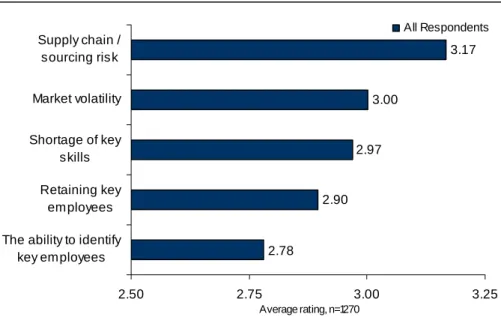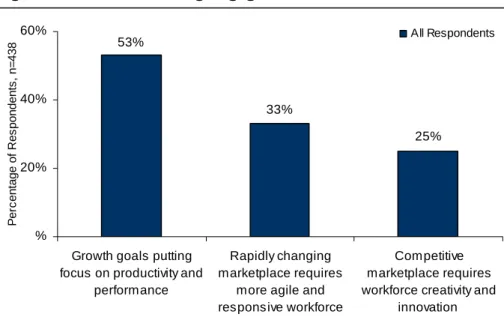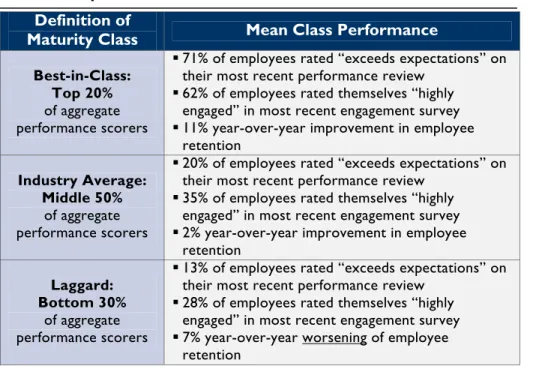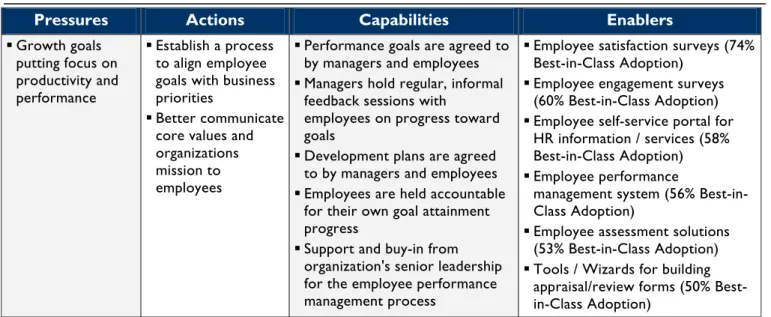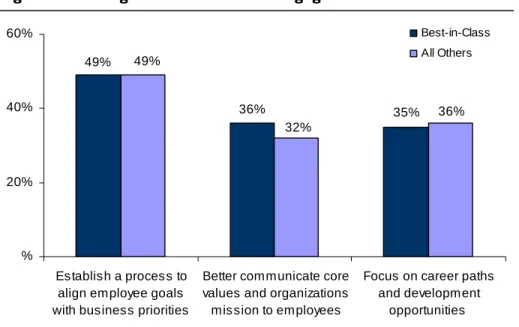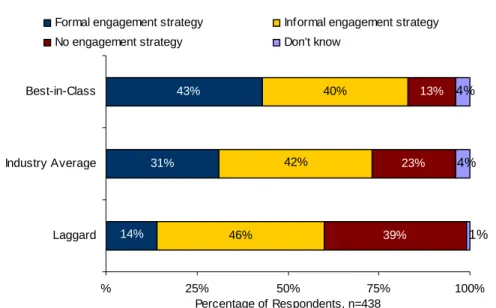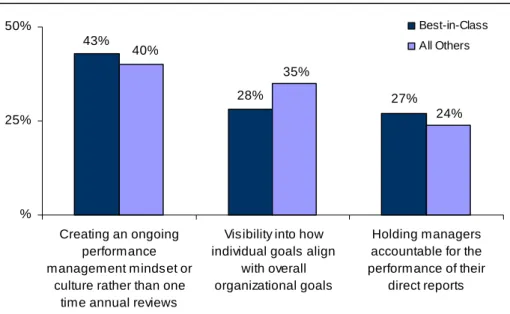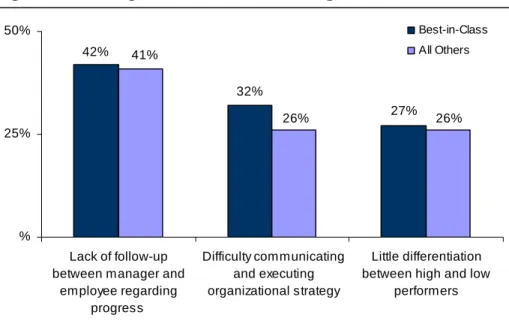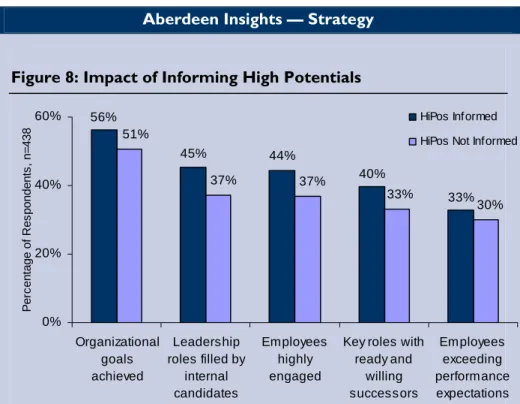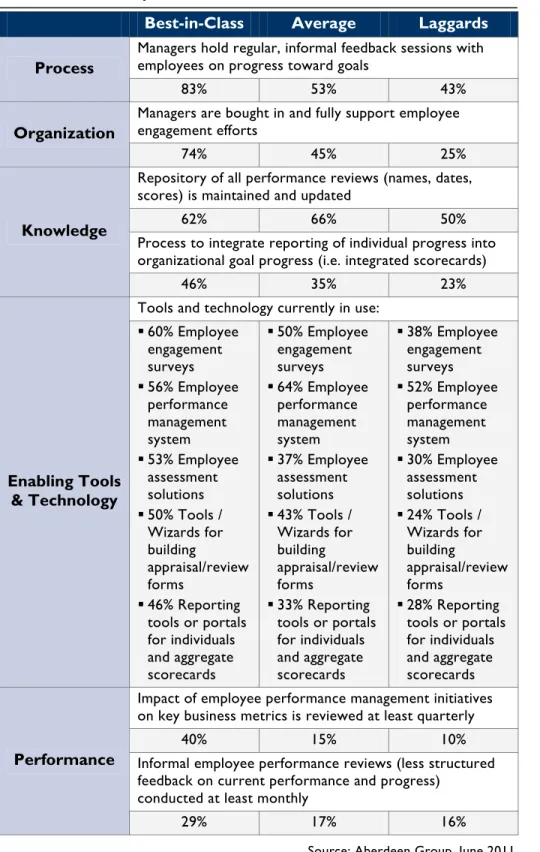The Engagement / Performance
Equation
July 2011
Mollie Lombardi
© 2011 Aberdeen Group. Telephone: 617 854 5200
Executive Summary
Research Benchmark Aberdeen’s Research Benchmarks provide an in-depth and comprehensive look into process, procedure, methodologies, and
technologies with best practice identification and actionable recommendations
Employee engagement and employee performance management truly go hand in hand. The goal for both is to create alignment between the needs, desires, skills and activities of individuals and what the business requires to achieve results. But in today's intense business environment, what managers and employees need to achieve this balance can be difficult to discern. This study of 438 organizations, surveyed in May and June 2011, examines strategies, tools and processes designed to improve engagement and performance to understand which are the most effective, and make
recommendations on how organizations can use them to improve employee retention, leadership bench strength, customer satisfaction and profitable growth.
Best-in-Class Performance
Aberdeen used the following three key performance criteria to distinguish Best-in-Class companies:
• 71% of employees rated “exceeds expectations” on their most recent performance review
• 62% of employees rated themselves “highly engaged” in most recent engagement survey
• 11% year-over-year improvement in employee retention
Competitive Maturity Assessment
Based on these findings, the firms enjoying Best-in-Class performance shared several common characteristics, including:
• Senior leaders that establish a culture of alignment and ongoing communication
• Tools and practices that provide visibility and transparency into individual and organizational goals and progress
• Full accountability among individuals and managers for business results
Required Actions
In addition to the specific recommendations in Chapter Three of this report, to achieve Best-in-Class performance, companies must:
• Work with senior leaders to get buy-in and support for engagement and performance management efforts
• Give managers the tools to deliver effective feedback and reviews
• Instill accountability at the individual and managerial level for the achievement of personal and team goals
This document is the result of primary research performed by Aberdeen Group. Aberdeen Group's methodologies provide for objective fact-based research and represent the best analysis available at the time of publication. Unless otherwise noted, the entire contents of this publication are copyrighted by Aberdeen Group, Inc.
Table of Contents
Executive Summary...2
Best-in-Class Performance...2
Competitive Maturity Assessment...2
Required Actions...2
Chapter One: Benchmarking the Best-in-Class...4
Business Context ...4
The Maturity Class Framework...6
The Best-in-Class PACE Model ...7
Best-in-Class Strategies...7
Chapter Two: Benchmarking Requirements for Success...14
Competitive Assessment...15
Capabilities and Enablers...17
Chapter Three: Required Actions ...22
Laggard Steps to Success...22
Industry Average Steps to Success ...22
Best-in-Class Steps to Success...23
Appendix A: Research Methodology...25
Appendix B: Related Aberdeen Research...27
Figures
Figure 1: Challenges to Meeting Business Goals...4Figure 2: Pressures Driving Engagement Efforts ...5
Figure 3: Strategic Actions to Build Engagement...8
Figure 4: Performance Among Best-in-Class Organizations...8
Figure 5: Prevalence of Formal Engagement Strategy...9
Figure 6: Activities with the Biggest Impact on Performance...10
Figure 7: Challenges to Performance Management...11
Figure 8: Impact of Informing High Potentials ...13
Figure 9: Critical Organization Capabilities ...18
Figure 10: Tools Supporting Performance Management...20
Tables
Table 1: Top Performers Earn Best-in-Class Status...6Table 2: The Best-in-Class PACE Framework ...7
Table 3: Most Important Skills ...11
Table 4: The Competitive Framework...16
Table 5: Impact of Frequent, Informal Reviews ...20
Table 6: The PACE Framework Key ...26
Table 7: The Competitive Framework Key ...26
Table 8: The Relationship Between PACE and the Competitive Framework ...26
Chapter One:
Benchmarking the Best-in-Class
Business Context
Fast Facts
√ 43% of Best-in-Class organizations have a formal engagement strategy, while just 14% of Laggards do In today's marketplace, organizations are looking for any competitive edge
they can find. They need to move faster, work smarter, and perform better than ever before. Recent years have been tough, but many individuals and organizations are ready to think about growth again. Participants in
Aberdeen's Q1 2011 Quarterly Business Review, which looked at over 1200 organizations worldwide, cited organic growth as the number one goal for their organizations in the coming year. But this growth will face many challenges, and chief among them are people challenges. As Figure 1 shows, of the top five challenges, three are directly related to people - finding, keeping, and segmenting them.
Figure 1: Challenges to Meeting Business Goals
3.17 3.00 2.97 2.90 2.78 2.50 2.75 3.00 3.25
The ability to identify key employees Retaining key employees Shortage of key skills Market volatility Supply chain / sourcing risk Average rating, n=1270 All Respondents
Rated on a scale of 1-5, from least to most challenging Source: Aberdeen Group, June 2011 Organizations hoping to overcome these challenges will need to better manage not only their external environment through things like better supply chain risk mitigation and hedging against market volatility, but learn to better manage talent risk. To achieve the kind of growth organizations are looking for, it comes down to enabling better business execution, which requires the right talent, carefully managed, to deliver superior results. This requirement is where employee engagement and employee performance come in.
The July 2009 study on Employee Engagement established Aberdeen's definition of engagement as the alignment of individual priorities, goals and
The Best Managers… √ Given the important role
managers play in driving engagement and performance, survey respondents were asked to describe what the best, most effective managers do differently to help motivate, align and get the best from their employees. These responses appear throughout the report.
desires with the needs of the organization in order to deliver business results. Engagement is not to be confused with employee satisfaction, which is all about the needs of the individual being met through their affiliation with the organization. Engagement is defined by its impact on improving alignment and results. And it has also proven to be a driver of retention, as well as a powerful tool for attracting new talent. And as further sections of this report will show, by focusing specific engagement efforts on high-performing and high-potential individuals organizations have a better chance of keeping them on board and grooming them as future leaders. Engagement is so intertwined with driving performance, and the tools, processes and organizational capabilities required to manage both are so similar, it is impossible to talk about one without the other. And together they form a powerful equation to improve business results.
Productivity, Agility and Innovation
Organizations are focused on employee engagement as a business driver as well. As Figure 2 illustrates, organizations are focusing on engagement as a solution for productivity, agility and innovation.
Figure 2: Pressures Driving Engagement Efforts
53% 33% 25% % 20% 40% 60%
Growth goals putting focus on productivity and
performance
Rapidly changing marketplace requires
more agile and responsive workforce
Competitive marketplace requires workforce creativity and
innovation P e rc e nt age of R es p ond ent s , n= 43 8 All Respondents
Source: Aberdeen Group, June 2011 And in fact, when asked to rank the importance of employee engagement to improving your organization's performance in key areas, its impact on individual employee performance rated highest, with a score of 4.5 (on a scale of 1 to 5 where “1” equals not important and “5” equals critically important). As Aberdeen's July 2010 analyst insight Effective Talent Management Drives Profitable Business Growth pointed out, an engaged workforce drives engaged customers that in turn power organizational growth. The following sections of this document further explore this
connection, laying out the tools and strategies that top-performing organizations use to achieve these kinds of performance results.
The Maturity Class Framework
Aberdeen used three key performance criteria to distinguish the Best-in-Class from Industry Average and Laggard organizations:
• Employee performance, defined as the percentage of employees who received a rating of "exceeds expectations" as of their latest performance review. This is an indicator of how well organizations are able to align an individual's efforts with the work that the organization expects from them.
• Employee engagement, defined as the percentage of employees who rated themselves as "highly engaged" in the most recent
engagement survey. This is a measure of the effectiveness of current engagement efforts.
"[ The best managers] Understand the talent within their team - both individual and collective - and work with them to break down the task and align the organizational mission to their goals and strengths."
~ Christa Dhimo, Director of Leadership and Organizational Development, Lantheus Medical Imaging • Employee retention, measuring the degree of improvement in
retention, defined as getting closer or further away from targeted turnover rates. This is a measure of how well organizations maintain desired talent and exit those individuals not aligned with
organizational priorities.
The purpose of these metrics is to call out the organizations achieving and exceeding engagement, performance and alignment goals and to further understand what they are doing differently to achieve those results. Table 1 describes the mean class performance of the three segments analyzed. Table 1: Top Performers Earn Best-in-Class Status
Definition of
Maturity Class Mean Class Performance
Best-in-Class: Top 20%
of aggregate performance scorers
71% of employees rated “exceeds expectations” on their most recent performance review
62% of employees rated themselves “highly engaged” in most recent engagement survey
11% year-over-year improvement in employee retention
Industry Average: Middle 50%
of aggregate performance scorers
20% of employees rated “exceeds expectations” on their most recent performance review
35% of employees rated themselves “highly engaged” in most recent engagement survey
2% year-over-year improvement in employee retention
13% of employees rated “exceeds expectations” on their most recent performance review
Laggard: Bottom 30%
of aggregate performance scorers
28% of employees rated themselves “highly engaged” in most recent engagement survey
7% year-over-year worsening of employee retention
The Best-in-Class PACE Model
Improving employee engagement and performance is an outcome borne of many intersecting activities and processes. The critical elements include:
• Establishing a culture of alignment and ongoing communication
• Tools and practices that provide visibility and transparency into individual and organizational goals and progress
• Full accountability among individuals and managers for business results
Table 2: The Best-in-Class PACE Framework
Pressures Actions Capabilities Enablers
Growth goals putting focus on productivity and performance Establish a process to align employee goals with business priorities
Better communicate core values and organizations mission to employees
Performance goals are agreed to by managers and employees
Managers hold regular, informal feedback sessions with
employees on progress toward goals
Development plans are agreed to by managers and employees
Employees are held accountable for their own goal attainment progress
Support and buy-in from organization's senior leadership for the employee performance management process
Employee satisfaction surveys (74% Best-in-Class Adoption)
Employee engagement surveys (60% Best-in-Class Adoption)
Employee self-service portal for HR information / services (58% Best-in-Class Adoption)
Employee performance
management system (56% Best-in-Class Adoption)
Employee assessment solutions (53% Best-in-Class Adoption)
Tools / Wizards for building appraisal/review forms (50% Best-in-Class Adoption)
Source: Aberdeen Group, June 2011
Best-in-Class Strategies
If any further evidence is required to show the power of engagement to drive performance, it can be found in Figure 3. This figure shows that the number one strategy to improve engagement is to strengthen the performance culture. Engagement is all about aligning individuals with the organization, which is exactly the aim of goal setting. When people know what is expected of them, it becomes easier for them to execute against that. And when they do, and start to reap the rewards of meeting and exceeding those goals, they want to do more of it - simultaneously improving engagement as well as performance.
Figure 3: Strategic Actions to Build Engagement 49% 36% 35% 49% 32% 36% % 20% 40% 60% Establish a process to align employee goals with business priorities
Better communicate core values and organizations mission to employees
Focus on career paths and development
opportunities
Best-in-Class All Others
"[The best managers] Find opportunities to develop team members, and vary their management style based upon situation - directing new tasks, supporting when needed, delegating when appropriate."
~ Erin Packwood, HR Business Partner, Chemtura Corporation
Source: Aberdeen Group, June 2011 This focus on individual alignment and achievement is important because there is compelling data which shows that when employee engagement and performance is high, many other critical company-wide metrics are
improved as well, from hiring the best talent, to bench strength, to overall organizational performance and customer retention (Figure 4).
Figure 4: Performance Among Best-in-Class Organizations
41% 46% 30% 25% 36% 31% 21% 74% 70% 63% 59% 34% 0% 25% 50% 75% 1st choice candidates accepting offers Organizational goals achieved Leadership roles filled by internal candidates
Key roles w ith ready and w illing
successors P er c e nt age of R es p ond ent s , n = 43 8 Best-in-Class Industry Average Laggard
Source: Aberdeen Group, June 2011 As shown in Figure 1, beyond external risk management, finding, retaining and developing talent are the biggest challenges organizations face.
-in-r th customer retention and revenue per Full Time
-
8%
strategy and six-times those with no strategy (6%, 3% and 1% respectively). Figure 5: Prevalence of Formal Engagement Strategy
Improving employee engagement and performance is critical to solving all of those. In addition to the performance improvements shown below, Best Class companies also saw three and a half times greater year-over-yea improvement in bo
Equivalent (FTE).
And it's also important to note that a formal strategy around engagement is a part of this success. Best-in-Class organizations are almost three times as likely as Laggards to put a formal engagement strategy in place (Figure 5 see sidebar for definition). And organizations with a formal engagement strategy achieved on average, 18% more of their organizational goals in the past 12 months than those with an informal strategy (60% vs. 51%), and 8 more than those with no engagement strategy (60% vs. 32%). They also improved revenue per FTE two times greater than those with an informal
Definition
This research defined a form engagement strategy as o with clear programs initiatives in place, documentation of results stakeholder buy-in, and accountability 39% 23% 13% 14% 31% 43% 46% 42% 40% 1% 4% 4% % 25% 50% 75% 100% Laggard Industry Average Best-in-Class Percentage of Respondents, n=438
Formal engagement strategy Informal engagement strategy
No engagement strategy Don't know al
ne or
, across the organization
Source: Aberdeen Group, June 2011
s st
te
The Chicken or the Egg?
While the linkage between engagement and performance has been proven, knowing which comes first (does engagement drive performance or does performance drive engagement?) is hard to tease out. But the data doe show that alignment is at the core of engagement, and that improved performance is the result of aligned execution. But in the end, the mo important thing to remember is that both must be measured by the yardstick of overall business performance. Forty-six percent (46%) of Best-in-Class organizations indicate they have clearly defined metrics to evalua the success of employee engagement initiatives and are 64% more likely than all others (the Industry Average and Laggard companies combined) to do so. An engagement score only means so much - correlating that score to
out the lifecycle by Best-in-Class organizations are all perfo
•
business results is the critical linkage. And the top activities identified to improve engagement through
rmance focused:
Engagement activity most critical while on-boarding employees: Having new employee agree with his/her manager to performance
• critical for developing employees:
expectations and development plan Engagement activity most
Mentoring and coaching
• Engagement activities most critical for retaining employees: Frequent, informal feedback meetings with direct manager and updates from senior leadership on the organizational vision and
e activities ranked as having the greatest performance impact (Figure 6).
Figure 6: Activities with the Biggest Impact on Performance performance (tied).
These activities closely mirror th
43% 28% 27% 40% 35% 24% % 25% 50% Creating an ongoing performance management mindset or
culture rather than one time annual reviews
Visibility into how individual goals align
with overall organizational goals
Holding managers accountable for the performance of their
direct reports
Best-in-Class All Others
"[The best managers] Focus o constant communication an feedback on performance, recognizing
n d good work in the mom
Resource Generalist,
Software ent.”
~Holly Konieczny, Human Progress
Source: Aberdeen Group, June 20 With a spotlight on performance among organizations today, with a bit of planning and focus, making the case for the kinds of investments of energy required to improve engagement (and as a result, improve
11 time and
ls e it a
d that to the individual level, and translating it into guidance for day-to-day performance) should be easier, but organizations still face critical challenges. Even though the data shows that a focus on engaging and aligning individua can have a rapid, direct impact on performance, it's still hard to mak reality. As Figure 7 shows, much of this has to do with the fact that engagement and performance must be driven down to a personal, one-to-one level to be effective. Without ongoing follow-up between managers an employees, without ongoing communication of overall strategy, cascading
execution, initiatives to improve engagement and performance will be stymied.
Figure 7: Challenges to Performance Management
42% 32% 27% 41% 26% 26% % 25% 50% Lack of follow-up between manager and
employee regarding progress Difficulty communicating and executing organizational strategy Little differentiation between high and low
performers
Best-in-Class All Others
Source: Aberdeen Group, June 2011 Overcoming these challenges requires strong managers, and the right skills being taught to all people-leaders within the organization. Aberdeen's October 2010 study on Learning & Developmentfound that the main goal organizations had for their learning programs was to foster business
alignment, and when it came to the skills responding organizations indicated must be in place to make that a reality, people skills top the list (Table 3). Table 3: Most Important Skills
Best-in-Class Skills
(Scale of 1 - 5: "1" is least important and "5" is most important)
Leadership skills (people management, strategy, etc.) 4.55
Communication skills 4.33
Critical thinking / decision making 4.25
People development skills (giving and receiving feedback, etc.) 4.24 Source: Aberdeen Group, Learning & Development, October 2010 There is still often a "code of silence" among managers who hesitate to ask for help gaining the skills they need to engage and manage the performance of their teams. But this gap must be addressed so that managers are given the skills they need to play an active role in improving the alignment of their team and team members with organizational strategy. In Chapter Two we will explore in more detail the critical capabilities, summarized in Table 2,
that managers must have in order to make engagement and performance goals a reality.
Aberdeen Insights — Strategy
The third challenge highlighted in Figure 7 is around differentiation. The full description of this challenge was "little differentiation between high and low performers, making it difficult to make informed compensation and promotion decisions." This is an important challenge to address, because both compensation and advancement decisions can impact engagement, retention, and the ongoing viability of the organization. Aberdeen's July 2010 study on Succession Management found that among Best-in-Class companies, the number one criteria for determining high-potential status was performance review ratings, followed by 360-degree reviews. With so much riding on performance ratings, calibration is critical as well. Just 45% of Best-in-Class organizations indicate that they have performance rating calibration discussions to drive normalized and consistent ratings, compared to 35% of Laggards. Without a strong process to deliver fair, accurate, timely performance reviews, this vital piece of information that so many organizations rely on when making investments in the future of individual careers may not be reliable. Differentiation of high potential employees is an important strategy when it comes to improving engagement and performance. Eighty-four percent (84%) of Best-in-Class organizations in this study indicate they have a process in place to identify high potential employees, as compared to 67% of all others. And not only do these organizations identify who the high potential individuals are, they also tell people about it. Best-in-Class employers are 24% more likely to tell the individual when they are designated high-potential (57% vs. 46%), two times as likely to tell the individual's peers (13% vs. 6%) and almost four times as likely to let the entire organization know (15% vs. 4%) than all other companies. It is this critical step of not only identifying these top performing, high potential individuals, but to tell them about it. As Figure 8 shows, when the individual knows how much they are valued, knows that the organization has plans to invest in them as a potential future leaders, performance and engagement rise, along with retention and bench strength.
continued
"[The best managers] Provide clear linkages between individual performance objectives and business goals, and utilize ongoing, informal recognition strategies."
~ Stephanie Vincent, Internal Communications Manager, FMG
Aberdeen Insights — Strategy
Figure 8: Impact of Informing High Potentials
56% 45% 44% 40% 33% 51% 37% 30% 33% 37% 0% 20% 40% 60% Organizational goals achieved Leadership roles filled by internal candidates Employees highly engaged
Key roles with ready and willing successors Employees exceeding performance expectations P e rc e nt age of R es p ond ent s , n= 43 8 HiPos Informed HiPos Not Informed
Source: Aberdeen Group, June 2011 Differentiation is also important when it comes to compensation. Among Best-in-Class companies, 68% indicate that employee performance is linked to variable compensation, as compared to 60% of the Industry Average and 49% of Laggards. Without differentiated performance ratings to drive that compensation, it could be wasted funds. No top-performer wants to hear that even though they outperformed their peers, everyone is getting the same bonus. And as Bob Kelleher, Founder and CEO of The Employee Engagement Group said during the Aberdeen Human Capital Management Summit last year, "If you allow mediocre performance to persist, you will disengage top performers.” Differentiation in where to invest from a compensation as well as development perspective will be a critical talent risk management strategy for organizations going forward.
In the next chapter, we will see what the top performers are doing to achieve these gains.
Chapter Two:
Benchmarking Requirements for Success
Engagement and performance management must be woven into the fabric of the organization to be truly effective, and this commitment starts with the leaders. Without the right skills, behaviors and buy-in from leadership, all the tools and processes in the world will not be enough to truly raise the bar on alignment, commitment and results from employees.
Case Study — Merck
Merck is a global healthcare organization whose stated mission is to “help the world be well.” The organization serves customers in 140 countries, has over 96,000 employees, and generates $46B in sales a year, putting it among the top 10 pharmaceutical companies in the world. Merck operates in an industry that has been rife with merger and acquisition (M&A) activity in the past several years, and has itself undergone growth via M&A. In 2009, Merck acquired Schering-Plough Pharmaceuticals, which itself had just acquired Organon BioSciences two years earlier. With each acquisition the new entities nearly doubled in employee size, and finding ways to bring those employees together without losing focus on business priorities was a mission critical activity. Going through two such mergers in rapid succession offered a unique opportunity to share learning from one experience to the next, and across the entire process, the performance management process became a strong facilitator of the M&A experience.
In 2007, when Schering-Plough acquired Organon BioSciences, day one of the new organization came just as both organizations were about to embark on their year-end review cycle. The decision was made that performance management would play a key role in getting employees aligned around the new organization and reinforce the right behaviors. But to minimize disruption for employees it was decided that each individual would go through the process as they were accustomed as part of whichever side of the new organization they came from – Organon employees through their existing process and Schering-Plough through theirs – while working behind the scenes to roll out a new, integrated process and next release of their performance management system for the following year. While this did allow for lots of time for
communications and buy in, it also created some difficulties for managers. “Managers now had new blended teams from both organizations,” said Jamie Whitmore, Director, Executive Talent Management, Merck. “So while employees had a familiar experience and we had time to do good change management leading into the new process, managers were caught in the middle using two systems and processes.” While there were execution challenges, the strategy of using performance management to bring the two companies together was effective. And, as it turned out,
continued
Fast Facts
√ Best-in-Class companies are
81% more likely to provide managers with training and tools on strategies for engaging employees and 24% more likely to train managers and supervisors to deliver effective performance reviews
Case Study — Merck
provided valuable lessons learned for the next merger right around the corner.
Day one of the Merck acquisition of Schering-Plough was almost two years to the day after the previous one, and just eight weeks after the new performance management system had been rolled out at Schering-Plough. And once again performance management was at the heart of bringing the people together in support of the “One Merck” vision for the new organization. This time around, however, the team decided not to wait on integrating everyone on one system and one process. “This time around we led with one technology, one process to get people focused and integrated quickly,” said Whitmore. “Anything we might lose in change management, we made up for in integration and speed.” In less than 100 business days, the organization launched it’s new, integrated global performance management solution for all of the nearly one
hundred thousand Merck employees.
Some of the key reasons this speed was important included not only impact on business results, but impact on engagement and retention. It put a focus on desired behaviors and business priorities, as well as brought attention to individual development opportunities. “In a merger individuals can get nervous about their place in the new organization. A process to facilitate feedback and the setting of performance and
development goals was very helpful in retaining the talent we needed as a business,” said Whitmore. And it also brought attention to pay for performance and linkage to corporate scorecards. This alignment has paid off for Merck, not only in terms of satisfaction with the performance management tool and process, but in overall business results, with a score of 107 (out of 100) on it’s company balanced scorecard in it’s first year as a combined entity. In a large and rapidly changing organization, performance management became the thread to tie individual actions, behaviors, buy-in and alignment with the business, setting a bright stage for the future of Merck.
Competitive Assessment
Aberdeen Group analyzed the aggregated metrics of surveyed companies to determine whether their performance ranked as Best-in-Class, Industry Average, or Laggard. In addition to having common performance levels, each class also shared, differentiated characteristics in five key categories: (1) process (the approaches they take to execute daily operations); (2) organization (corporate focus and collaboration among stakeholders); (3) knowledge management (contextualizing data and exposing it to key stakeholders); (4) technology (the selection of the appropriate tools and the effective deployment of those tools); and (5) performance
management (the ability of the organization to measure its results to improve its business). These characteristics (identified in Table 4) serve as a
guideline for best practices, and correlate directly with Best-in-Class performance across the key metrics.
Table 4: The Competitive Framework
Best-in-Class Average Laggards
Managers hold regular, informal feedback sessions with employees on progress toward goals
Process
83% 53% 43%
Managers are bought in and fully support employee engagement efforts
Organization
74% 45% 25%
Repository of all performance reviews (names, dates, scores) is maintained and updated
62% 66% 50%
Process to integrate reporting of individual progress into organizational goal progress (i.e. integrated scorecards) Knowledge
46% 35% 23%
Tools and technology currently in use:
Enabling Tools & Technology 60% Employee engagement surveys 56% Employee performance management system 53% Employee assessment solutions 50% Tools / Wizards for building appraisal/review forms 46% Reporting tools or portals for individuals and aggregate scorecards 50% Employee engagement surveys 64% Employee performance management system 37% Employee assessment solutions 43% Tools / Wizards for building appraisal/review forms 33% Reporting tools or portals for individuals and aggregate scorecards 38% Employee engagement surveys 52% Employee performance management system 30% Employee assessment solutions 24% Tools / Wizards for building appraisal/review forms 28% Reporting tools or portals for individuals and aggregate scorecards Impact of employee performance management initiatives on key business metrics is reviewed at least quarterly
40% 15% 10%
Informal employee performance reviews (less structured feedback on current performance and progress)
conducted at least monthly Performance
29% 17% 16%
Capabilities and Enablers
Based on the findings of the Competitive Framework and interviews with end users, Aberdeen’s analysis of the Best-in-Class shows that organizations achieving the highest levels of employee engagement and performance share three key qualities. These employers establish from the top a culture alignment and ongoing communication; put in place tools that provide visibility and transparency into individual and organizational goals and progress; and hold individuals and managers accountable for business results.
Process
"[The best managers] Offer effective feedback and coaching, and provide opportunities for growth and development through well crafted
development plans. It's all about follow through!”
~ Michele Doucet, Talent Management, Bell Aliant Process capabilities are all about the "what" - what do top-performing
companies do differently to make the kind of results they achieve a reality. And when it comes to delivering engagement and performance, this process starts with goals - both setting them and managing them on an ongoing basis. The top capability overall among Best-in-Class organizations was simply agreement on performance goals between the manager and
employee, cited by 88% (as compared to 77% of all others). The majority of all organizations see this as critical, but where the top performers
differentiate themselves is in the capability listed in Table 4, providing the ongoing, informal feedback on progress against those goals - something Best-in-Class companies are 66% more likely to do (83% vs. 50%).
This type of ongoing communication isn't just a happy accident for these top performers either. While some managers have innate skills or dispositions that help them be more engaging leaders that instinctively give great feedback, others may struggle mightily with the concept. So it shouldn't be surprising that Best-in-Class companies are 81% more likely to provide managers with training and tools on strategies for engaging employees (56% vs. 31%), and 24% more likely to train managers and supervisors to deliver effective performance reviews (57% vs. 46%). Giving better feedback, helping team members set proper goals, and the ability to track and
communicate progress are things that can be learned. Companies that want Best-in-Class performance need to consider how they are supporting managers with the tools and training required for setting and managing the right goals that will deliver results.
Organization
Organizational culture and support plays a huge role in engagement and performance. Aberdeen defines these capabilities as those pertaining to corporate focus and collaboration among stakeholders, and as Figure 9 illustrates, support and buy-in from both senior leadership as well as front-line and mid-level managers is critical for both performance management and engagement efforts. And senior leaders at Best-in-Class companies are just as bought-in on engagement as they are on performance, because these leaders know that motivated, aligned effort from their employees is the key to unlocking ongoing performance results.
Figure 9: Critical Organization Capabilities 66% 42% 54% 38% 74% 72% 72% 74% 0% 20% 40% 60% 80% Senior leadership support for performance management Senior leadership support for engagement efforts Manager support for performance management Manager support for engagement efforts P e rc en tag e of R e s p o nden ts , n= 438
Best-in-Class All Others
Source: Aberdeen Group, June 2011 It is also very telling that the single most differentiated capability in any category is the organizational capability listed in Table 4, "managers are bought in and fully support employee engagement efforts." Best-in-Class organizations are 95% more likely to have this capability in place than all others (74% vs. 38%). This is important because, as noted in the process section above, managers play a huge role in executing performance
management and engagement efforts. They are where the rubber meets the road for engaging employees by providing that feedback, translating strategy and providing visibility into performance. Without their buy-in, execution and more importantly, improvement, is nearly impossible.
Knowledge Management
Contextualizing data and making it available to the right stakeholders to drive better decisions is what knowledge management capabilities are all about. The importance of this kind of access increases along with the number of stakeholders involved. Given the importance of alignment, communication and visibility, it makes sense that strength in knowledge management takes on critical importance in supporting performance management and engagement efforts. Simple access to performance review data is one element, which 61% of all organizations currently have in place. But another capability, while not as widely adopted, is even more strongly correlated to improved performance, and that is the presence of integrated scorecard capabilities. While currently just under half (46%) of the Best-in-Class have this capability, they are twice as likely as Laggards to do so (23%). As will be further explored in the performance management section below, accountability at all levels - for personal goal attainment and for managerial goal attainment in which team members progress against goals- is a key trait of top performers. Tools like scorecards that track and display data around
progress against key goals help in ensuring this accountability by giving all parties a clear line of sight and a common set of data. Taking this a step further to include integrated scorecards that bring together individual progress into a picture of organizational progress where leaders can drill down and roll up goals and progress to get a clear picture of activity is very helpful when it comes to remediating performance issues. It also allows those individuals and managers doing well to be readily identified and used as examples or guides to help others who may be struggling. The goal is to keep information flowing that allows managers and leaders to continue to give the ongoing feedback so strongly associated with improved
performance.
Enabling Tools & Technology
Measurement tools showed up among the top enablers for Best-in-Class organizations, including employee satisfaction surveys (74%), employee engagement surveys (60%), and other employee assessment solutions (53%). Performance management and indeed engagement are about making an evaluation of alignment, and these types of tools help provide data and serve as inputs to the kinds of scorecards and reporting mentioned above.
Aberdeen's May 2011 study on Talent Management Assessments found that Best-in-Class organizations were 23% more likely than all others to integrate assessment data with performance management processes (53% vs. 43%).
In addition to these kinds of measurement tools, another key supporting technology is the performance management system itself. Currently, 59% of all respondents to this study indicate they have one currently in place, making it the most commonly cited enabling tool or technology. This number goes up to 73% if you look at organizations with over 1,000 employees (compared to 43% of those organizations with less than 1000 employees), demonstrating its increasing importance when managing the performance process across a larger enterprise. Along with these kinds of overall performance management solutions, several key tools are used by top performers to manage specific aspects of the process (Figure 10).
Figure 10: Tools Supporting Performance Management 36% 41% 39% 28% 50% 49% 43% 36% 0% 20% 40% 60%
Tools / wizards for building appraisal forms Tools to create individual development plans Tools to manage rating distribution and calibration Tools / wizards to craft SMART goals P e rc en tag e of R e s p o nden ts , n= 438
Best-in-Class All Others
Source: Aberdeen Group, June 2011
Performance Management
"[The best managers] Give regular feedback, set clear expectations and goals, offer recognition and focus on aligning development plans."
~ Deborah Brantley, Senior Human Resources Executive, AlliedBarton Security Services The last category of capabilities is performance management, which in the
case of employee engagement and performance management must happen on two levels - individual and organizational. From an individual perspective, the most differentiated process capability shown in Table 4 is managers holding regular informal feedback sessions with employees on progress. But how regular is regular? Only 29% of Best-in-Class companies indicate that informal performance reviews are held at least monthly. If you extend the time period to quarterly, the number goes to just over half (51%), as
compared to just 26% of Laggards indicating quarterly informal reviews. This frequency is important, as shown in Table 5, which compares the
performance of organizations with at least monthly informal reviews against those with less frequent feedback cycles.
Table 5: Impact of Frequent, Informal Reviews
Metric Monthly At least Quarterly or Less
Organizational goals achieved 56% 47%
Employees highly engaged 47% 36%
Employees exceeding performance expectations 32% 28%
Improvement in customer retention 7% 3%
Improvement in revenue per FTE 6% 3%
Improvement in employee retention 4% 1%
Source: Aberdeen Group, June 2011 Accountability for performance is important as well. Seventy-six percent (76%) of Best-in-Class organizations hold individuals accountable for their own goal attainment (vs. 61% of all others) and 67% hold managers
accountable for employee goal attainment among their team members (vs. 44% of all others). This kind of cascading accountability is something that managers must be prepared for at all levels of the organization as they learn to influence not only their own outcomes, but those of their team
members. And on the organizational level, one shocking data point from this study was the fact that 35% of Laggards indicate that they never evaluate the impact of employee performance management initiatives on key business metrics. These organizations are operating on blind faith that their employee performance management efforts are driving business results without ever verifying it.
Aberdeen Insights — Rewards and Recognition
One critical element in managing and improving both employee performance and engagement is rewards and recognition. Feedback is critical, but so is celebration and acknowledgement of goals achieved and progress made. Currently 65% of Best-in-Class organizations indicate they have formal rewards and recognition programs in place, as compared to 57% of Industry Average and 46% of Laggards. This is an area of growth as well, with another 22% of organizations in each performance class indicating they plan to put such a program in place in the coming year. Organizations with formal reward and recognition programs also reporting achieving, on average 53% of their organization's overall goals versus just 39% goal attainment for organizations with no formal program in place - an impressive outcome for such a focus on alignment.
In support of these programs, 44% of Best-in-Class organizations have tools to enable peer-to-peer recognition and performance feedback. This provides further validation for the culture of performance identified in Chapter One as a critical element for engagement and performance. Just 25% of Laggards support these kinds of tools currently. And while just 26% of Best-in-Class companies have an online system in place to manage all of their reward and recognition activity, they are 24% more likely than all others to do so (21%). These tools are an area of massive growth however, with another 32% of Best-in-Class companies planning to adopt such technologies, making it one of the top three enablers these
Chapter Three:
Required Actions
Fast Facts
√ 84% of Best-in-Class organizations hold formal reviews on an annual or semi-annual basis, but 51%
also have at least quarterly informal reviews
√ Among Laggards, only 77%
hold annual or semi-annual formal reviews, and just 26%
provide informal feedback on a quarterly or more frequent basis
Whether a company is trying to move its performance from Laggard to Industry Average, or Industry Average to Best-in-Class, the following actions will help spur the necessary performance improvements:
Laggard Steps to Success
• Work with senior leaders to get buy-in and support for engagement and performance management efforts.
Organizations look to leaders to signal what the priorities are, so if improving performance is the goal, executives must set the example. Only 58% of Laggards indicate that senior leaders are supportive of employee performance management efforts, compared to 71% of the Industry Average and 74% of Best-in-Class. And just 28% indicate that leaders are bought into engagement efforts, which is two and a half times less likely than the Best-in-Class. Given the need for improved organizational performance, senior leaders have to get on board with the strategies that will improve individual alignment and effort in order to see organization-wide results.
• Give managers the tools to deliver effective feedback and reviews. Just 34% of Laggards provide training for managers on performance reviews (vs. 53% of Industry Average), and only 21% provide tools and training on engaging employees (vs. 36% of Industry Average). Managers are not all created equal when it comes to evaluating performance, developing and engaging others. Providing this critical layer of the organization with the right tools is a good first step to lay the foundation for improved performance management and improved organizational results.
• A formal performance appraisal process is not enough - managers must also provide ongoing feedback. Laggards are only about half as likely as Best-in-Class employers to indicate that managers give regular, informal feedback to their employees on how they are progressing toward goals (43% vs. 83%). It is telling that 84% of Best-in-Class organizations hold formal reviews on an annual or semi-annual basis, 51% also have at least quarterly informal reviews. Among Laggards, 77% hold annual or semi-annual formal reviews, and just 26% provide informal feedback on a quarterly or more frequent basis. Effective performance management is not about executing the annual review cycle, it's about the modifications and adjustments and course corrections day in and day out that keep the organization headed in the right direction.
Industry Average Steps to Success
• Instill accountability - at the individual and managerial level. As individual contributors, each employee has a role to play
in being accountable for their own progress. Currently, 62% of Industry Average organizations have a process in place to ensure this personal accountability, as compared to 76% of the Best-in-Class. Not only do organizations need to do more to encourage this individual accountability, they also need to hold managers accountable. It's a new skill when suddenly a leader must take responsibility not only for their own work, but learn to work through others. Like the leaders in the case study, managers must learn to take on accountability for the success of their team, something just 48% of Industry Average organizations have the capability to do, as compared to two-thirds (67%) of the Best-in-Class.
• Utilize assessments as part of ongoing performance
support and coaching. Assessments have shown to be critical to all aspects of talent management in multiple Aberdeen studies, and again in this report we see them as a differentiated capability of Best-in-Class organizations. Top performing companies are 43% more likely to use assessments than Industry Average organizations (53% vs. 37%). Data such as 360-degree feedback, assessments to gauge the impact of development programs, and even tools like personality profiles or motivational assessments that help managers better understand and work with their team members can all be a valuable part of an ongoing performance and engagement culture.
• Establish a formal process around rewards and recognition. As shown in Chapter Two, recognition and rewards can have a powerful positive impact on many talent and business metrics. While Industry Average organizations are 24% more likely than Laggards to have a formal employee recognition program in place (57% vs. 46%), they still lag behind the 65% of the Best-in-Class that do. And don't forget that peer-to-peer recognition can be powerful as well - any program or system to enable reward and recognition should encompass supervisor and peer-to-peer reinforcement of positive behaviors.
Best-in-Class Steps to Success
• Differentiate performance to differentiate compensation and development. Making better talent decisions and better stewardship of development and compensation investments are key in today's organizations. Organizations should continue to take a critical eye to calibration conversations so that top performers and individuals with potential are the targets of programs that will engage, retain and develop them. At 45% adoption, Best-in-Class organizations are 14% more likely than all others (40%) to have company-wide performance calibration conversations, but to continue to make better talent choices in a world of scarce resources, ongoing conversations on calibration and differentiation will be beneficial.
• Cascade goals and roll-up performance. At the core, engagement and performance are all about alignment. Tools that help create actionable goals at the individual level that align with strategic intents are important. But once those goals have been set, scorecards - at the individual, team and organization level provide visibility across multiple stakeholders into progress. They also allow leaders to drill down to identify issues, foster alignment, and create a backdrop to ongoing performance feedback conversations. Although Best-in-Class organizations are 48% more likely than all others (31%) to have integrated scorecards, just 46% currently do, leaving room for further adoption.
Aberdeen Insights — Summary
Engagement has been a buzzword for well over a decade in the human capital field, but the benefits it can bring amount to a lot more than just buzz. Engagement is, at its core, about alignment. Aligning the needs, desires, skills and efforts of an individual employee with the strategy of the organization. And the responsibility for making engagement a reality falls, for all intents and purposes, to managers. Each layer of management and leadership must be given the proper skills and tools to foster that alignment, all with the intent of driving individual, team and company performance. Because in the end, performance only improves when execution - the day to day efforts and activities of individual employees - is aligned with strategic intent. That differentiated performance is the powerful outcome of the engagement / performance equation.
Appendix A:
Research Methodology
Between April and May 2011, Aberdeen examined the use, the experiences, and the intentions of more than 438 enterprises using engagement and performance in a diverse set of industries and geographies.
Study Focus
Responding organizations completed an online survey that included questions designed to determine the following:
√ What strategies improve engagement and
performance
√ How tools can be used to align employee personal growth with enterprise growth
√ What processes are the most effective in improving employee retention, leadership bench strength, customer satisfaction and profitable growth The study aimed to identify emerging best practices for engagement and performance, and to provide a framework by which readers could assess their own management capabilities.
Aberdeen supplemented this online survey effort with interviews with select survey respondents, gathering additional information on engagement and performance strategies, experiences, and results.
Responding enterprises included the following:
• Job title: The research sample included respondents with the
following job titles: CEO / President (11%); EVP / SVP / VP / General Manager / Managing Director (17%); Director (18%); Manager (27%); Staff (12%); Consultant (10%) and other (4%).
• Department / function: The research sample included respondents from the following departments or functions: HR / talent
management (47%); corporate management (9%); business development, sales and marketing (10%); operations (8%); IT (5%) and other (21%).
• Industry: The research sample included respondents from a wide variety of industries. Some of the larger industries represented were IT consulting / services (9%); government (8%); financial services (6%), medical / healthcare (6%), software (4%).
• Geography: The majority of respondents (70%) were from North America. Remaining respondents were from Europe (12%); the Asia-Pacific region (11%); Middle East / Africa (5%): and South America (2%).
• Company size: Thirty-three percent (33%) of respondents were from large enterprises (annual revenues above US $1 billion); 31% were from midsize enterprises (annual revenues between $50 million and $1 billion); and 36% of respondents were from small businesses (annual revenues of $50 million or less).
• Headcount: Fifty-two percent (52%) of respondents were from large enterprises (headcount greater than 1,000 employees); 25% were from midsize enterprises (headcount between 100 and 999 employees); and 23% of respondents were from small businesses (headcount between 1 and 99 employees).
Table 6: The PACE Framework Key
Overview
Aberdeen applies a methodology to benchmark research that evaluates the business pressures, actions, capabilities, and enablers (PACE) that indicate corporate behavior in specific business processes. These terms are defined as follows:
Pressures — external forces that impact an organization’s market position, competitiveness, or business operations (e.g., economic, political and regulatory, technology, changing customer preferences, competitive)
Actions — the strategic approaches that an organization takes in response to industry pressures (e.g., align the corporate business model to leverage industry opportunities, such as product / service strategy, target markets, financial strategy, go-to-market, and sales strategy)
Capabilities — the business process competencies required to execute corporate strategy (e.g., skilled people, brand, market positioning, viable products / services, ecosystem partners, financing)
Enablers — the key functionality of technology solutions required to support the organization’s enabling business practices (e.g., development platform, applications, network connectivity, user interface, training and support, partner interfaces, data cleansing, and management)
Source: Aberdeen Group, July 2011 Table 7: The Competitive Framework Key
Overview
The Aberdeen Competitive Framework defines enterprises as falling into one of the following three levels of practices and performance:
Best-in-Class (20%) — Practices that are the best currently being employed and are significantly superior to the Industry Average, and result in the top industry performance.
Industry Average (50%) — Practices that represent the average or norm, and result in average industry
performance.
Laggards (30%) — Practices that are significantly behind the average of the industry, and result in below average performance.
In the following categories:
Process — What is the scope of process standardization? What is the efficiency and effectiveness of this process?
Organization — How is your company currently organized to manage and optimize this particular process?
Knowledge — What visibility do you have into key data and intelligence required to manage this process?
Technology — What level of automation have you used to support this process? How is this automation integrated and aligned?
Performance — What do you measure? How frequently? What’s your actual performance?
Source: Aberdeen Group, July 2011 Table 8: The Relationship Between PACE and the Competitive Framework
PACE and the Competitive Framework – How They Interact
Aberdeen research indicates that companies that identify the most influential pressures and take the most transformational and effective actions are most likely to achieve superior performance. The level of competitive performance that a company achieves is strongly determined by the PACE choices that they make and how well they execute those decisions.
Appendix B:
Related Aberdeen Research
Related Aberdeen research that forms a companion or reference to this report includes:
• Assessments 2011: Selecting and Developing for the Future; May 2011
• Onboarding 2011: The Path to Productivity; February 2011
• The 2011 HR Executives Agenda: Automation, Innovation and Growth; December 2010
• Learning & Development 2010: Bridging the Gap Between Strategy and Execution; October 2010
• Succession Management: Sustainable Leadership for the Future; July 2010
• Effective Talent Management Drives Profitable Business Growth; July 2010
• Beyond Satisfaction: Engaging Employees to Retain Customers; July 2009 Information on these and any other Aberdeen publications can be found at
www.aberdeen.com.
Author: Mollie Lombardi, Research Director, Human Capital Management (mollie.lombardi@aberdeen.com)
For more than two decades, Aberdeen's research has been helping corporations worldwide become Best-in-Class. Having benchmarked the performance of more than 644,000 companies, Aberdeen is uniquely positioned to provide organizations with the facts that matter — the facts that enable companies to get ahead and drive results. That's why our research is relied on by more than 2.5 million readers in over 40 countries, 90% of the Fortune 1,000, and 93% of the Technology 500.
As a Harte-Hanks Company, Aberdeen’s research provides insight and analysis to the Harte-Hanks community of local, regional, national and international marketing executives. Combined, we help our customers leverage the power of insight to deliver innovative multichannel marketing programs that drive business-changing results. For additional information, visit Aberdeen http://www.aberdeen.com or call (617) 854-5200, or to learn more about Harte-Hanks, call (800) 456-9748 or go to http://www.harte-hanks.com.
This document is the result of primary research performed by Aberdeen Group. Aberdeen Group's methodologies provide for objective fact-based research and represent the best analysis available at the time of publication. Unless otherwise noted, the entire contents of this publication are copyrighted by Aberdeen Group, Inc. and may not be reproduced, distributed, archived, or transmitted in any form or by any means without prior written consent by Aberdeen Group, Inc. (2011a)
